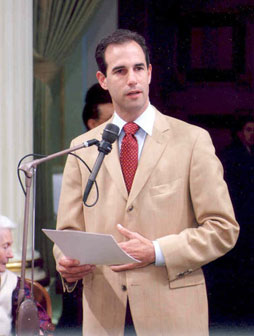California bill would outlaw incandescent light bulbs to help fight global warming
California bill would outlaw incandescent light bulbs to help fight global warming
Rhett A. Butler, mongabay.com
January 31, 2007
This week California Assemblyman Lloyd Levine (D-Van Nuys) will introduce legislation that would ban the sale of incandescent light bulbs in California by the year 2012. Levine says that incandescent light bulbs waste energy and better, more-cost alternatives are available.
“Incandescent light bulbs were first developed almost 125 years ago, and since that time they have undergone no major modifications,” Assemblymember Levine said in a statement. “Meanwhile, they remain incredibly inefficient, converting only about five percent of the energy they receive into light. It’s time to take a step forward — energy-efficient bulbs are easy to use, require less electricity to do the same job, cut greenhouse gas emissions, and save consumers money.”
 Assemblymember Levine presents legislation on the floor of the State Assembly. |
Citing research by the Rocky Mountain Institute (RMI), a nonprofit organization that focuses on energy policy, Levine says that replacing a 75-watt incandescent light bulb with a 20-watt compact fluorescent would result in the same amount of light but would save 1,300 pounds of carbon dioxide and save customers $55 over the life of the bulb.
“Electricity-saving technologies may not be glamorous, especially when compared with the idea of a shiny new power plant, but the facts are that there are hundreds of electricity-saving innovations now on the market that if fully used throughout the United States, would significantly decrease the electricity the country now uses,” Levine said. “The time has come for this legislation, and what better state to lead the charge than California.”
California has become a leader in carbon dioxide legislation. Last year California became the first state to impose binding limiting on greenhouse gas emissions. Earlier this year the state said it world create the world’s first global warming pollution standard for transportation fuels, reducing the carbon content in fuel 10 percent by 2020. California has also introduced a massive solar energy plan that would add 3,000 megawatts of solar energy over 11 years through the installation of 1 million rooftop solar energy systems on homes, businesses, farms, schools and public buildings.
Related
Energy efficiency helped California grow an extra $31 billion finds study. Countering Bush administration claims to the contrary, environmental officials for the state of California and the Brazilian state of Sao Paulo have found significant evidence that greenhouse gas pollution can be substantially reduced at a profit rather than a cost. The study, commissioned by the William and Flora Hewlett Foundation, found that energy efficiency has helped the California economy grow an extra 3 percent – a $31 billion gain – compared to business as usual. Further, the researchers say that each Californian typically saved about $1,000 per year between 1975 and 1995 just through efficiency standards for buildings and appliances.
California adopts massive solar energy project. The California Public Utilities Commission approved a $2.9 billion program to make the state one of the world’s largest producers of solar power. The plan would add 3,000 megawatts of solar energy over 11 years through the installation of 1 million rooftop solar energy systems on homes, businesses, farms, schools and public buildings. The amount of electricity generated would be equivalent to about six new power stations. Solar power could save California utility customers an estimated $9 billion from a reduced need to build new power plants and purchase electricity supplies at peak demand.